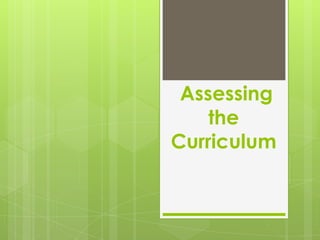
Assessing the curriculum
- 2. Curriculum assessment - process of collecting information for use in evaluation. - an important part of the systems approach to curriculum development.
- 3. Purposes: Highlight curriculum expectations. Gather information about what students know and can do. Motivate students to learn better. Motivate and encourage teachers to meet the identified needs of students. Provide evidence to tell how well the students have learned. Obtain feedback that helps teachers, students and parents make good decisions to guide instruction.
- 4. Types of Assessments 1. 2. 3. Intended Curriculum Implemented Curriculum Achieved Curriculum
- 5. 1. Intended Curriculum - refers to a set of objectives set at the beginning of any curricular plan - answers what the curriculum maker wants to do
- 6. Indicators to measure intended curriculum Are the objectives achievable with in the learner’s developmental levels? Can the objectives be accomplished with in the time frame? Are the resources adequate to accomplish the objectives? Are the objectives specific and clear? Are there ways of measuring the outcomes of the objectives? Are the objectives observable? Are the objectives doable? Are the objectives relevant? Overall, are the objectives SMART?
- 7. What does the BEC aim to accomplish? From the DEpEd BEC primer, the following are the goals of the basic education curriculum. To raise the quality of Filipino learners and graduates who will become lifelong learners To decongest the curriculum in order that the teachers and learners will be able to contextualize it
- 8. To muse innovative, interdisciplinary and integrative modes of instructional delivery whenever possible and appropriate To make values development integral to all learning areas in high school To increase time for tasks in order to gain mastery of competencies of the basic tool subjects
- 9. 2. Implemented Curriculum refers to the various learning activities or experiences of the students in order to achieve the intended curricular outcomes.
- 10. To assess the implemented curriculum the following questions can be addressed: Are the learning activities congruent with the stated objective Are the materials and methods appropriate for the objectives set?
- 11. Does the teacher have the skill to implement the activities or use the strategy? Does the teacher utilize the various ways of doing to complement the learning styles of the students? Are there alternative activities for the learners to do to accomplish the same objectives?
- 12. Are there activities provided to address individual differences? Do the activities provide maximum learning experiences? Do the activities motivate the learners to do more and harness their potentials? Do the activities utilize multiple sensory abilities of the learners? Do the activities address multiple intelligences of the learners?
- 13. How was the BEC implemented to accomplish the goals? The BEC decongest the overcrowded old curriculum into five learning areas, namely, English, Mathematics, Scien ce, Filipino and Makabayan. The first three subject areas will develop internationalism, while the last two learning areas will develop Filipinism. The teachers in basic education were trained to use innovative, interdisciplinary, thematic, and integrative modes of instructional delivery. Teachers of different disciplines plan and teach together in tandem or teams in all subject areas as possible.
- 14. Teaching- learning processes are interactive to enhance learning. There is open communication between teachers and learners and among learners themselves. Instructional materials and multimedia are fully utilized to support interactions thus teaching and learning become more interesting. Teachers consider the learner as an active partner rather than a passive receiver of knowledge. English, Science, Mathematics and Filipino are the basic tool subjects, while Makabayan develops healthy personal and national selfidentity. Makabayan entails the use of integrated units of learning areas composed of several subjects in the elementary and in the secondary levels.
- 15. 3. Achieved Curriculum Refers to the curriculum outcomes based on the first two types of curriculum Now considered the product. Any achieved curriculum must fit with the objectives and the activities that were conducted. Indicates the performance vis a vis the objectives and the various activities. Usually described by test scores or other performance indicators measured by evaluation tools.
- 16. To measure achieved curriculum: Do the learning outcomes achieved by the learners approximate the level of performance set at the beginning of the curriculum? Are the learning outcomes achieved higher or lower than the objectives set? Do the achieved learning outcomes reflect the knowledge, skills, attitudes and skills intended to be developed? How many percent of the learners in the same class perform higher than the level set at the beginning? Do the curricular outcomes reflect the goals and the aspirations of the community where the curriculum was implemented?
- 17. What has the BEC achieved? Increased interest and motivation of students to go to school Increased level of performance in the tool subject areas Change in teachers paradigm from a dispenser of knowledge to facilitators of learning Increased instructional materials support for teaching and learning Increase in the in-service training of teachers More opportunities of learners to learners to learn on their own Use of varied teaching strategies to complement the learning styles of students More involvement of other stakeholders in the education of the children More involvement of the school principals in the decision making that relate to curriculum implementation
- 18. Thank you!
